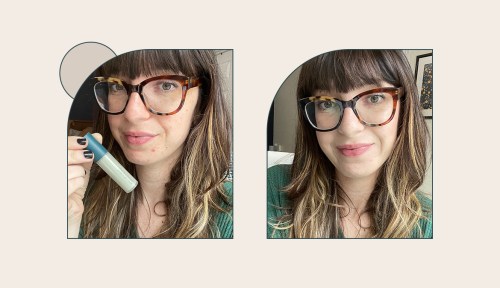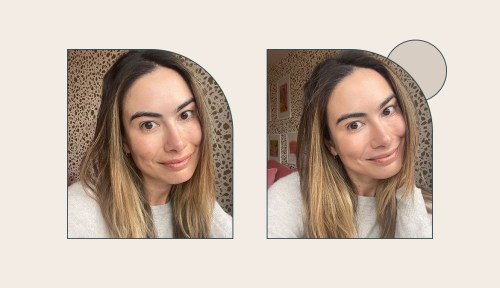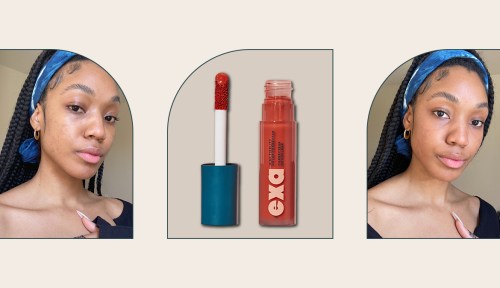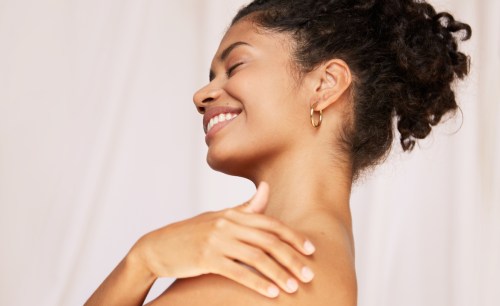Our editors independently select these products. Making a purchase through our links may earn Well+Good a commission
It can be tempting to cover up undereye circles, dark spots, and redness by piling on thick layers of concealer. But sometimes, no matter how much you add, you can still see discoloration peeking through. To prevent that, you want to start with a color corrector to block out some of the pigment before applying the rest of your complexion products. And lucky for us, the new Exa High Fidelity Balancing Color Corrector ($27) comes in six shades to make finding the right color correctors for your skin tone easier.
Experts in This Article
makeup artist and CEO and founder of Aliya Baig Academy of Makeup
Allie Compton is the product development manager at Exa.
Exa High Fidelity Balancing Color Correctors — $27.00
“Our formula is super-charged with a skin-care grade complexion brightening blend that’s powered by marshmallow root, licorice root, and rice bran extract to help reduce the appearance of dark spots over time. Meaning they actually work overtime to deliver instant and continuous treatment results,” says Allie Compton, Exa’s product development manager.
The correctors are made with an easy-to-blend formula that includes Kaolin, a type of clay to absorb excess oil (without drying out your skin) so they won’t crack, crease, or stand out under foundation.
How color corrector works
“Color correctors are like a filter IRL,” says Compton. “Upon application, they immediately adjust the hue, saturation, and brightness of the skin’s overall tone by bringing balance to any areas of discoloration or dullness.”
These types of products use color theory to neutralize discoloration. Say you’re dealing with redness. Take a look across to color wheel to red’s complementary color, green, and layer that on the red. The green will bring down the redness, creating a more neutral base for complexion-toned products to work their magic. Yellow cancels out purple while orange cancels out blue, both working to cover dark spots and hyperpigmentation. You want to look for pink to neutralize dark spots on lighter skin tones and move through peaches, orange, and red-orange as complexions get deeper.
“The color theory behind color correctors seems complicated, but they’re actually very quick and easy to use, and can make all the difference in your finished look,” says Compton. “All you have to do is find the right color corrector shade for your concerns, and you’re well on your way to achieving a radiant, natural skin finish. Adding this step will actually allow you to wear less makeup, so less concealer and foundation.”
To see how the shades work on different complexions, we had three Well+Good editors try it out. Learn about their thoughts below.
What it’s like using the Exa High Fidelity Balancing Color Corrector
Taylor, Deep Peach

“I don’t always like to use color correctors, but Exa has changed my mind about the wonders they can work,” says Taylor Bell, Well+Good’s senior commerce writer. “I have yellow undertones and a few faint dark spots on my cheeks that are always a pain to conceal. I usually have to pile on two different foundations over those darker areas to get an even blend. But with the Exa Color Corrector, I only had to use one layer of my regular Bobbi Brown Skin SPF foundation ($50). All in all, the corrector has a matte-like finish without being too cakey. And while it’s not meant to be a concealer, it definitely helps to smooth over any minor blemishes you may have.”
Gina, Green

“This color-corrector is pretty fool-proof and kind of makes you feel like you’re a professional makeup artist on the set of a movie,” says senior commerce editor Gina Vaynshteyn. “If you’re unsure how to use each shade and what it does, you just scan the bar code on the box, and it’ll lead you to the site where it shows you. I went with a neutralizing green, since I’m dealing with breakout city at the moment and want to neutralize the redness. I also applied some to my nose, which tends to get red thanks to irritation from my glasses. I then put on my foundation (today, it’s Kosas ($42)). The results are great—the green really does tone down the redness and give my complexion a brighter, more even look.”
Zoë, Pink

“To be honest, I’d never used a color corrector before this one came across my desk, but considering its recent virality on TikTok, I had high hopes for the results it would deliver,” says senior beauty editor Zoë Weiner. “My biggest discoloration concerns come from old acne scarring, which shows up brown on my complexion. So I used the pink tone to cover individual spots and blended it with my Rare Beauty Liquid Touch Concealer Brush ($16). I was legitimately shocked at how even my skin tone looked when I was done—so much so that I skipped my usual foundation and concealer and opted for only a shimmery sunscreen and loose powder instead. My dark spots were nearly invisible, and I love that I didn’t need to cake on makeup for the sake of the cause.”
How to apply color corrector
Like all makeup, you want to apply a color corrector to properly prepped skin. Start with your favorite moisturizer and, if you’d like, a hydrating primer. “Our color corrector applicator mimics a fingertip to help strategically place the product in areas of concern,” says Compton. “The formula is highly pigmented, so only a small amount of product is needed to achieve maximum results.”
Instead of applying color corrector all over, like you would a foundation, you only need it in spots where you’re experiencing discoloration. Makeup artist Aliya Baig suggests using a small synthetic brush ($22) for application to get the best coverage.
“Never use a beauty blender or stippling brush to apply a color corrector,” says Baig. “Start with a small synthetic brush the size of the area you’ll be working on. Then, gently use a damp blender to apply concealer or foundation over the area to blend.”
Though these work wonders under concealer and foundation, you can also sport color correctors on their own, depending on the severity of the areas of concern you wish to correct.
“I use the peach corrector alone under my eyes, and the under-eye dark circles with deep blue-purple veins vanish instantly,” says Baig. “We also have fans of the corrector mixing the yellow or green in with their primer, moisturizer, or SPF to create a skin evening and brightening base. Our products are meant to be mixed and matched; there are no rules. Deep Peach and Red Orange worn as liquid blushes are so gorgeous, too.”
Want to be the first to hear about the latest (and greatest) SHOP product drops, custom collections, discounts, and more? Sign up to have the intel delivered straight to your inbox.
Sign up for the Well+Good SHOP Newsletter
Get exclusive deals on wellness, beauty, fitness, and food products that have been hand-picked by our editors.
Got it, you've been added to our email list.









